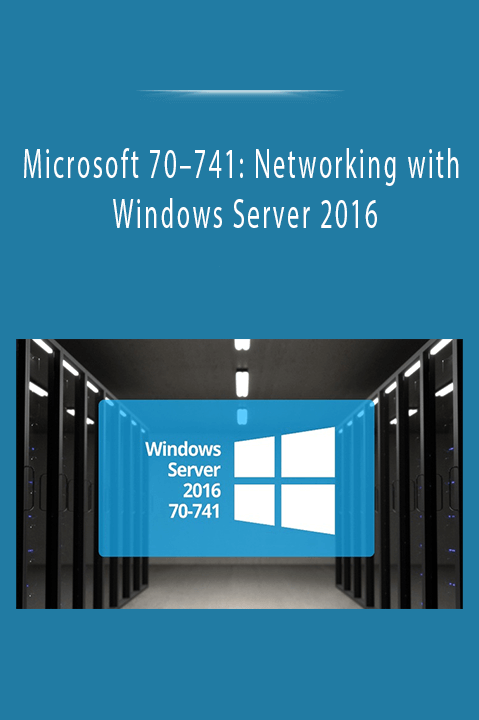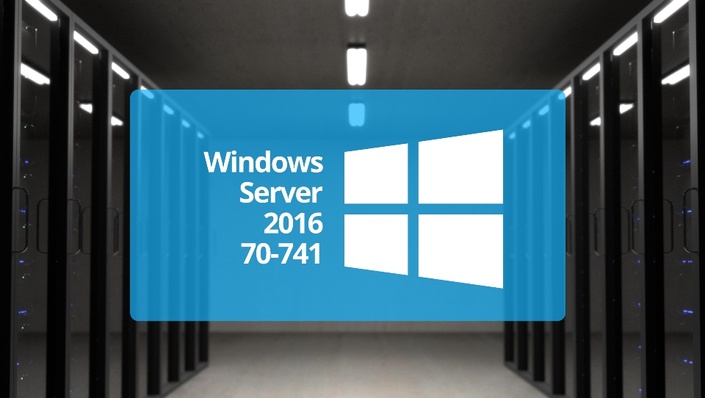Microsoft 70-741: Networking with Windows Server 2016
This course, 70-741: Networking with Windows Server 2016, covers the essential networking skills required to design, deploy, configure and support Windows Server 2016 in most organizations. It elaborates on the TCP/IP fundamentals, remote access technologies, and more advanced content including Software Defined Networking.
The course 70-741: Networking with Windows Server 2016 is part of a three course series required to pass the MCSA: Windows Server 2016 certification. The course curriculum is designed keeping in view the exam topics covered in the Microsoft exam 70-741. In this way, this course is equally helpful for IT professionals looking to gain their knowledge as well as the candidates willing to appear in the said exam.
Career Path: The 70-741 exam is geared toward network administrators that are looking to reinforce their existing skills and learn about new networking technology changes and functionality in Windows Server 2016.
Course Curriculum
Course Introduction
Course Introduction (3:23)
Instructor Introduction (1:24)
Chapter 01 – Plan and Implement IPv4 and IPv6 Networks
Chapter 1 Introduction (2:39)
Topic A: Plan and Implement IP Addressing Schemes for IPv4 Networks (1:28)
General Networking Requirements (4:55)
IPv4 Required Settings (3:27)
IPv4 Addresses (2:40)
IPv4 Subnet Masks (3:58)
Default Gateways (2:19)
Demo – Understanding Binary Addressing (12:29)
IPv4 Address Classes (5:20)
What are Subnets? (1:54)
The Subnetting Method (3:25)
Subnet Creation Process (3:29)
Demo – Subnetting a Network (21:34)
IPv4 Address Types (7:25)
IPv4 Network Types (2:15)
Demo – Examining VLSM (13:38)
Topic B: Configuring IPv4 Hosts (0:49)
IPv4 Configuration (2:30)
IPv4 Configuration Tools (2:42)
Demo – Configuring IPv4 (12:04)
Topic C: Managing and Troubleshooting IPv4 Connectivity (0:37)
Network Routing (3:50)
Working with Routing Tables (1:33)
Adding Static Routes (2:28)
IPv4 Troubleshooting Methodology (3:16)
Command Line Troubleshooting Tools (3:37)
Graphical Troubleshooting Tools (1:33)
Troubleshooting with Windows PowerShell (2:07)
Demo – Troubleshooting IPv4 (14:32)
Microsoft Message Analyzer (1:23)
Topic D: Implementing IPv6 for Network Hosts (1:14)
The Purpose of IPv6 (0:56)
Reasons to Use IPv6 (2:29)
Comparing IPv4 and IPv6 (2:21)
IPv6 Address Structure (3:22)
IPv6 Address Types (3:14)
IPv6 Autoconfiguration (3:49)
Configuring IPv6 (1:18)
Tools for Configuring IPv6 (1:25)
Topic E: Implementing IPv6 Transitioning and Coexistence (0:44)
Understanding Node Types (2:27)
Options for Coexistence (1:47)
IPv6 over IPv4 Tunneling (2:15)
Understanding ISATAP (2:20)
Understanding 6to4 (1:43)
Understanding Teredo (2:11)
Transitioning Process (2:23)
Chapter 01 Summary (1:56)
Chapter 01 Review (0:10)
Chapter 01 Quiz
Chapter 02 – Installing and Configuring DHCP
Chapter 2 Introduction (1:07)
Topic A: Overview of the DHCP Server Role (0:20)
Introducing DHCP (2:08)
DHCP Components and Processes (3:06)
Lease Generation Process (3:37)
Lease Renewal Process (3:11)
DHCP Considerations (3:32)
Topic B: Deploying DHCP (0:13)
Install and Configure a DHCP Server (2:25)
DHCP Authorization (3:54)
Demo – Installing DHCP (7:23)
Creating Scopes (3:14)
Configuring DHCP Options (2:12)
Demo – Creating and Configuring Scopes (13:06)
DHCP Relay Agents (3:20)
Topic C: Managing and Troubleshooting DHCP (0:23)
Implementing Security for DHCP (5:22)
DHCP Auditing (1:27)
Demo – Configuring Security and Auditing (8:44)
DHCP Advanced Options (2:58)
Additional Scope Types (3:00)
High Availability for DHCP (4:10)
DHCP Failover (4:11)
Demo – Configuring DHCP Failover (5:21)
DHCP Database (4:27)
Migrating DHCP (1:23)
Troubleshooting DHCP (5:25)
Chapter 02 Summary (1:32)
Chapter 02 Review (0:10)
Chapter 02 Quiz
Chapter 03 – Installing and Configuring DNS
Chapter 03 Introduction (1:53)
Topic A: Implementing DNS Servers (0:43)
Name Resolution Basics (1:55)
What is DNS? (5:09)
DNS Namespace (1:40)
Types of Names (1:24)
Internet Name Resolution (3:25)
DNS Components (3:34)
DNS Zones and Resource Records (1:56)
Installing the DNS Server (2:04)
Demo – Installing DNS (5:43)
Topic B: Creating and Configuring DNS Zones (0:32)
Resource Records (4:02)
Zone Types (4:40)
Replicating Zones (2:49)
Demo – Creating and Configuring DNS Zones (16:57)
Standard DNS Name Resolution (1:33)
Modifying DNS Name Resolution (2:15)
Working with DNS Cache (2:53)
Demo – Configuring Cache and Forwarding (6:16)
Understanding Domain Delegation (2:42)
Demo – Domain Delegation (7:11)
Topic C: Understanding Active Directory Integration (0:21)
Overview of AD DS and DNS Integration (2:16)
SRV Records (2:36)
Demo – Examining SRV Records (6:01)
Active Directory Integrated Zones (4:07)
Application Partitions (3:30)
Demo – Configuring Active Directory Integrated Zones (4:46)
Topic D: Configuring Advanced DNS Settings (0:24)
Advanced Name Resolution (5:09)
The GlobalNames Zone (2:26)
Demo – Configuring the GlobalNames Zone (5:43)
Split DNS (4:12)
Introducing DNS Policies (2:04)
DNS Policy Objects (2:20)
Demo – Configuring DNS Policies (10:38)
Implementing DNS Security (3:30)
DNS Security (DNSSEC) (1:48)
Implementing DNSSEC (2:37)
Topic E: Troubleshooting DNS Name Resolution (0:24)
Introduction to DNS Troubleshooting (1:29)
Obtaining DNS Server Statistics (0:50)
Command Line Tools (1:00)
Troubleshooting Process (1:47)
Managing DNS Services (0:48)
Testing DNS Servers (1:12)
Demo – Managing and Troubleshooting DNS (19:12)
Chapter 03 Summary (1:38)
Chapter 03 Review (0:10)
Chapter 03 Quiz
Chapter 04 – Implementing and Managing IP Address Management
Chapter 04 Introduction (1:03)
Topic A: Overview of IPAM (0:34)
Introducing IPAM (3:04)
IPAM Benefits (1:04)
New Features in Windows Server 2016 (2:13)
IPAM Architecture (2:46)
IPAM Deployment Requirements (2:06)
IPAM Deployment Considerations (3:03)
Topic B: IPAM Deployment (0:13)
Implementing IPAM (2:23)
Demo – Installing and Provisioning the IPAM Role (23:02)
IPAM Administration (2:30)
Default IPAM Groups (1:57)
Demo – Administering IPAM (6:44)
Configuring IPAM Options (2:12)
Demo – Managing DNS and DHCP Servers using IPAM (9:44)
Topic C: Managing IP Address Spaces by using IPAM (1:11)
Managing IP Addressing (1:07)
Viewing and Managing IP Addressing (2:31)
Monitoring DHCP and DNS Servers (1:32)
Adding Address Spaces (1:01)
Finding, Allocating, and Reclaiming (1:48)
Demo – Managing IP Addressing with IPAM (6:27)
Chapter 04 Summary (1:37)
Chapter 04 Review (0:10)
Chapter 04 Quiz
Chapter 05 – Implementing Remote Access
Chapter 05 Introduction (1:23)
Topic A: Remote Access Overview (0:15)
What is Remote Access? (3:07)
Remote Access Options (1:51)
Managing Remote Access (1:10)
Demo – Installing the Remote Access Role (3:38)
The Remote Access Management Console (1:47)
Network Policy Server (2:33)
NPS Policies (4:16)
Using a PKI for Remote Access (4:33)
Routing with Windows Server 2016 (1:33)
Network Address Translation (2:45)
Topic B: Implementing the Web Application Proxy (0:14)
Overview of Web Application Proxy (3:23)
Authentication Options (3:04)
Configuring the Web Application Proxy (1:45)
Topic C: Planning and Implementing VPNs (0:16)
Remote Access with VPNs (3:28)
VPN Connection Properties (1:38)
Tunneling Protocols (5:31)
Authentication Protocols (4:47)
VPN Reconnect (1:31)
App – triggered VPNs (2:22)
Configuring a VPN Server (1:53)
VPN Configuration Options (2:50)
Demo – Configuring a VPN Server (6:59)
Topic D: Overview of DirectAccess (0:38)
Introducing DirectAccess (2:02)
DirectAccess Components (5:20)
Deployment Options (1:53)
DirectAccess Server Prerequisites (1:25)
Tunneling Protocol Options (2:04)
DirectAccess Process Internally (1:51)
DirectAccess Process Externally (6:12)
Topic E: Implementing DirectAccess (0:15)
Simple DirectAccess Configuration (0:37)
Configuration Changes (3:48)
Limitations of Simple Configuration (2:40)
Advanced DirectAccess Options (2:12)
High Availability (3:26)
Multisite Deployments (1:35)
Configuring a PKI for DirectAccess (2:48)
Implementing Client Certificates (1:37)
Internal Network Configuration Options (3:53)
Configuring DNS Settings (2:11)
Monitoring DA Connectivity (1:41)
Chapter 05 Summary (2:09)
Chapter 05 Review (0:10)
Chapter 05 Quiz
Chapter 06 – Installing and Configuring Branch Office Networking
Chapter 06 Introduction (1:05)
Topic A: Configuring Networking for Branch Offices (0:23)
Branch Office Scenarios (4:09)
Considerations for Branch Offices (3:17)
WAN Connectivity (3:17)
Network Services for Branch Offices (3:07)
Implementing RODCs (5:37)
Demo – Installing an RODC (8:12)
Presentation Virtualization (2:01)
Remote Desktop Services (2:12)
File Services for Branch Offices (2:44)
Print Services for Branch Offices (4:01)
Topic B: Implementing Distributed File Systems (0:36)
Introducing DFS (2:01)
DFS Components (1:11)
Types of DFS Namespaces (3:12)
Deploying DFS Namespaces (4:49)
Creating and Managing a DFS Namespace (1:23)
Demo – Creating a DFS Namespace (8:50)
DFS Replication (5:03)
DFS Scenarios (3:26)
Demo – Configuring Replication (5:38)
Optimizing DFS (5:16)
Managing the DFS Database (1:25)
Monitoring and Troubleshooting DFS (1:40)
Topic C: Implementing BranchCache (0:15)
Introducing BranchCache (1:44)
BranchCache in Windows Server 2016 (1:06)
BranchCache Modes (2:15)
Data Retrieval using BranchCache (2:29)
BranchCache Requirements (3:09)
Demo – Configuring and Enabling BranchCache (8:31)
Chapter 06 Summary (1:59)
Chapter 06 Review (0:10)
Chapter 06 Quiz
Chapter 07 – Implementing Advanced Networking Features
Chapter 07 Introduction (1:38)
Topic A: Implementing Networking Features for High Performance (0:10)
High Performance Networking Features (0:45)
NIC Teaming (3:45)
Demo – Implementing NIC Teaming (5:54)
SMB 3.1.1 Shared Folders (2:00)
Advanced SMB 3.1.1 Functionality (5:59)
Quality of Service (QoS) (2:12)
Understanding RSS (1:16)
Understanding RSC (1:36)
Topic B: Implementing Hyper-V Advanced Networking Features (0:24)
Virtual Switch Improvements (4:36)
Extensible Virtual Switch (2:19)
Understanding SR-IOV (1:26)
Dynamic VMQ (1:50)
Advanced Features for Network Adapters (2:00)
NIC Teaming in Virtual Machines (0:42)
Topic C: Introduction to Software-Defined Networking (0:22)
SDN Concepts and Tools (3:21)
SDN Benefits (1:52)
Planning for Software-Defined Networking (1:15)
SDN Deployments (2:57)
Topic D: Overview of Network Virtualization (0:18)
Introduction to Network Virtualization (1:30)
Network Virtualization Benefits (2:44)
Generic Route Encapsulation (2:02)
Chapter 07 Summary (1:40)
Chapter 07 Review (0:10)
Chapter 07 Quiz
Course Closure (2:13)
Instant Access Available
Downloadable Content
Get Instant Download Microsoft 70–741: Networking with Windows Server 2016 at Offimc.click Now!
Salepage: https://integrity.training/p/microsoft-70-741-networking-with-windows-server-2016
Delivery Information
- Upon ordering the product, a delivery email with download instructions will be sent immediately to you so that you may download your files. If you log in (or create an account) prior to purchase you will also be able to access your downloads from your account dashboard.
- It is a digital download, so please download the order items and save them to your hard drive. In case the link is broken for any reason, please contact us and we will resend the new download link to you.
- If you don't receive the download link, please don’t worry about that. We will update and notify you as soon as possible from 8:00 AM – 8:00 PM (UTC+8).
- Please Contact Us if there are any further questions or concerns you may have. We are always happy to assist!








6 reviews for Microsoft 70–741: Networking with Windows Server 2016
There are no reviews yet.